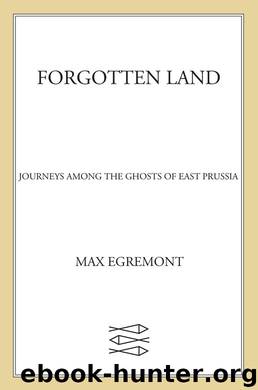Forgotten Land by Max Egremont

Author:Max Egremont
Language: eng
Format: epub
Publisher: Farrar, Straus and Giroux
Published: 2011-09-26T16:00:00+00:00
15: The Great Wilderness
East and north from Olsztyn, you enter the lakeland, reaching the resort of Mikołajki with its masted boats on the waterfront, summer tourists and winter emptiness. German papers and books about the old times are on sale all year round in the shops, including a guide to the route of Marion Dönhoff’s 1941 ride. Away from the lake, off the road from Olsztyn and Mragowo, is the austere evangelical church, said to have been designed by the Prussian neo-classical architect Karl Friedrich Schinkel.
The German Frank Dombrowski has taught in Mikołajki since 1991, in a private school named after Marion Dönhoff which she visited most years. We met some years ago, not long after he’d moved east. Frank Dombrowski said he loved the region and this was why he’d come, avoiding any suggestions of German guilt or duty or wish to escape. It was the history that moved him – did I know that Mikołajki was on an old Hanseatic route that led to Vladivostok? East Prussia had been fought over for centuries. You could learn about European history just by being here.
Dombrowski had been born in Königsberg, too late to remember the German city well. But he felt he had to tell me that the region had gone back since 1945 – mostly because the communists had wrecked it. Tourism seemed to be the best hope. People were open and kind – the children easier and more disciplined than in Germany and France where he’d also taught. Summer was wonderful but winter went on and on, with not enough to do – apart from some ice sailing and skating. The Russians came to Poland because there was more money, sometimes waiting for days to get across the frontier.
Frank Dombrowski was speaking in 1992, and now it’s better or at least different. I’ve crossed the border by train and by bus and had no trouble, as a rich tourist from the west – and what Dombrowski said has happened: tourism is still the hope. Farming and forestry don’t employ enough people because the farming companies that have moved in are highly mechanized, using seasonal rather than permanent labour. There’s a huge spa hotel outside Mikołajki and the streets are lined with restaurants, most open (and empty) even in the winter snow. Venice seems not so far away on the bridge over a wide grey canal that links two lakes – but the channel that runs into the huge Spirdingsee or Polish Jezioro niardwy points to a distant wilderness, quite different to the Adriatic or its shores. Lorenz Grimoni thinks that East Prussia now offers one of the wildest parts of Europe.
The tourist trail re-shapes the past. Red-brick castles have become hotels and restaurants at Ryn and Nidzica or museums at Ktrzyn and Lidzbark Warmiski; fields have camping sites and woodland has been cleared for a theme park about the original Prussians (not their German conquerors). Signs in German point to Hitler’s eastern headquarters – the Wolfsschanze or Wolf’s Lair, where massive slabs of tumbled concrete form chambers of ghostly significance.
Download
This site does not store any files on its server. We only index and link to content provided by other sites. Please contact the content providers to delete copyright contents if any and email us, we'll remove relevant links or contents immediately.
| Belgium | France |
| Germany | Great Britain |
| Greenland | Italy |
| Netherlands | Romania |
| Scandinavia |
Room 212 by Kate Stewart(5067)
The Crown by Robert Lacey(4760)
Endurance: Shackleton's Incredible Voyage by Alfred Lansing(4715)
The Iron Duke by The Iron Duke(4318)
The Rape of Nanking by Iris Chang(4165)
Joan of Arc by Mary Gordon(4051)
Killing England by Bill O'Reilly(3968)
Say Nothing by Patrick Radden Keefe(3936)
I'll Give You the Sun by Jandy Nelson(3393)
Shadow of Night by Deborah Harkness(3324)
Hitler's Monsters by Eric Kurlander(3287)
Mary, Queen of Scots, and the Murder of Lord Darnley by Alison Weir(3170)
Blood and Sand by Alex Von Tunzelmann(3164)
Eleanor & Park by Rainbow Rowell(3104)
Darkest Hour by Anthony McCarten(3095)
Margaret Thatcher: The Autobiography by Thatcher Margaret(3044)
Book of Life by Deborah Harkness(2891)
Red Famine: Stalin's War on Ukraine by Anne Applebaum(2889)
The One Memory of Flora Banks by Emily Barr(2827)
